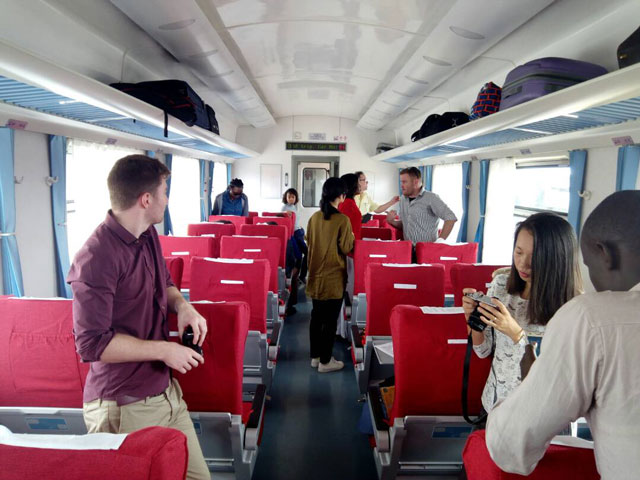
Nairobi, Kenya | AFP | More than a century after a colonial railway gave birth to modern Kenya, the country is betting on a new Chinese-built route to cement its position as the gateway to East Africa.
The $3.2 billion (2.8 billion euro) railway linking Nairobi with the port city of Mombasa will Wednesday take its first passengers on the 472 kilometre (293 mile) journey, allowing them to skip a hair-raising drive on one of Kenya’s most dangerous highways.
The railway is the country’s biggest infrastructure project since independence, and while it has courted controversy, it is a key selling point for the ruling Jubilee party ahead of August elections.
It is also part of a “master plan” by east African leaders to connect their nations by rail, with the Standard Gauge Railway (SGR) planned to eventually link Uganda, Rwanda, South Sudan, Burundi and Ethiopia.
“There is no country which has ever developed without having a very robust railway system. It was long overdue,” Kenya’s Transport Minister James Macharia told AFP.
He said not upgrading the railway in over 100 years “has dragged us backwards in terms of development.”
Launched the cargo freight services of the Standard Gauge Railway at Port Reitz Station in Mombasa #GoKDelivers pic.twitter.com/Bta7h2aPI0
— Uhuru Kenyatta (@UKenyatta) May 30, 2017
– The ‘Lunatic Express’ –
It was on May 30, 1896, that colonial Britain began building a railway from what is today Kenya’s coast to improve access to the riches of Uganda, showing little interest in the wild land in between.
The railway, steeped in tales of swashbuckling colonial adventure and beloved by tourists up until its last, creaking journey in April, is credited with shaping Kenya into its current form.
The capital Nairobi, today a regional hub, was a swampy outpost with no particular attraction until it became the headquarters of Kenya Railways.
The construction of the railway is the stuff of legend, with British and Indian workers terrorised by a pair of lions said to have devoured some 135 men.
The train was later dubbed the “Lunatic Express”.

– ‘Bad negotiations’ –
Some see a touch of folly in its successor too.
In as much as the old line traced the development of colonial Kenya, the new railway has proven a mirror for modern Kenya: dogged by corruption accusations, battling environmental concerns while trying to position itself as the gateway to east Africa.
The World Bank, and others, warned that building a new railway, instead of refurbishing the old one, was by far the most expensive option.
However, the government went ahead with the project, skipping an open tender to make a direct deal with China — whose Export‑Import Bank has loaned Kenya 90 percent of the venture’s cost.
“We should ask: ‘Why did you negotiate this badly’?” said Kwame Owino, head of the Nairobi-based Institute of Economic Affairs.
He points to similar Chinese-built railways in Ethiopia, Tanzania and elsewhere on the continent which cost much less per kilometre.
Macharia dismisses this argument, saying Kenya’s SGR could carry more cargo, and passes through trickier terrain.
He said the government expects the railway to boost GDP by 1.5 percent, allowing them to pay back the loan “in about four years”.
“I think that is a little bit of wishful thinking,” said Owino, questioning assumptions about the volume of cargo available to be carried, while warning high growth rates in east Africa were beginning to moderate.
He said the government, whose debt has doubled in three years, would be forced to raise taxes to cover the bill.
“My feeling as an economist is that it is going to be a white elephant, but as a taxpayer I hope not,” said Owino.
Trucks currently take two days to carry goods from Mombasa to Nairobi, while the train will take eight hours. Passenger trains will take around five hours.
The railway will be managed by the Chinese contractor for five years, with 610 Chinese workers in charge, while Kenyans are trained to take over.
– Environmental woes –
The railway has also concerned environmentalists, as it cuts through a key wildlife migration route.
Ben Okita of Save The Elephants said that while underpasses have been built to allow elephants to cross, the creation of an embankment and fencing around the new railway was creating deadly confusion.
Previously one or two elephants were killed annually, but since 2016, 10 elephants have been hit on the old route.
“They are used to crossing the old line and then they get to the new railway line and they find the fence and they get confused, in the process they are hit by a train,” said Okita.
The next leg of the SGR, to connect Nairobi with the Rift Valley town of Naivasha at a cost of $1.5 billion has also caused a furore as it will cut through the capital’s iconic national park.
The government is currently negotiating the financing to link Naivasha to Kisumu near the Ugandan border, which Macharia says is expected to cost another $3.5 billion.
SGR will put Kenya on the path to industrialisation especially in manufacturing and value addition. #GOKdelivers #MombasaCounty pic.twitter.com/FPfv70MShy
— Kenya Railways (@KenyaRailways_) May 30, 2017
Finishing touches before President @UKenyatta officially launches the new SGR Cargo Train service.#SGRLaunchKe#KenyaYasongaMbio pic.twitter.com/9BNhqeJmCi
— SGR Kenya (@SGR_Kenya) May 30, 2017
 The Independent Uganda: You get the Truth we Pay the Price
The Independent Uganda: You get the Truth we Pay the Price



